Mae Hong Son Province
Mae Hong Son Province (Thai: แม่ฮ่องสอน, pronounced [mɛ̂ː.hɔ̂ŋ.sɔ̌ːn]; Shan: မႄႈႁွင်ႈသွၼ်; Northern Thai: ![]() ; formerly called Mae Rong Son), also spelled Maehongson, Mae Hong Sorn or Maehongsorn, is one of Thailand's seventy-six provinces (changwat) lies in upper northern Thailand and is the westernmost province. Neighboring provinces are (clockwise from north) Shan State of Myanmar, Chiang Mai and Tak. To the west, the province borders Kayin State and Kayah State of Myanmar.
Mae Hong Son's nickname is "the city of three mists". It is hemmed in by the high mountain ranges of the Shan Hills and is the most mountainous province in Thailand, occupying 12,681 square kilometres (4,896 sq mi).[2] The province is often covered with mist. Mae Hong Son town was originally established in the early 19th century as an elephant training camp as ordered by the then King of Chiang Mai.
As of 2012 Mae Hong Son was the poorest province in Thailand.[5]
; formerly called Mae Rong Son), also spelled Maehongson, Mae Hong Sorn or Maehongsorn, is one of Thailand's seventy-six provinces (changwat) lies in upper northern Thailand and is the westernmost province. Neighboring provinces are (clockwise from north) Shan State of Myanmar, Chiang Mai and Tak. To the west, the province borders Kayin State and Kayah State of Myanmar.
Mae Hong Son's nickname is "the city of three mists". It is hemmed in by the high mountain ranges of the Shan Hills and is the most mountainous province in Thailand, occupying 12,681 square kilometres (4,896 sq mi).[2] The province is often covered with mist. Mae Hong Son town was originally established in the early 19th century as an elephant training camp as ordered by the then King of Chiang Mai.
As of 2012 Mae Hong Son was the poorest province in Thailand.[5]
Mae Hong Son
แม่ฮ่องสอน | |
|---|---|
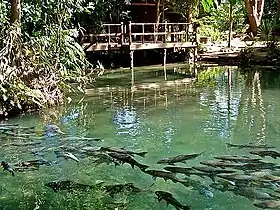 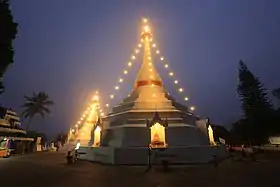 Schools of rock mahseer, Tham Pla–Namtok Pha Suea National Park, Mueang Mae Hong Son and Pang Mapha Districts (above), Wat Phrathat Doi Kongmu, a provincial temple in which the main chedi contains Buddha's relics on the hill of the capital district (below) | |
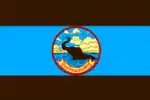 Flag 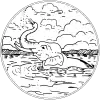 Seal | |
| Nickname(s): Mueang Sam Mok (city of three mists) | |
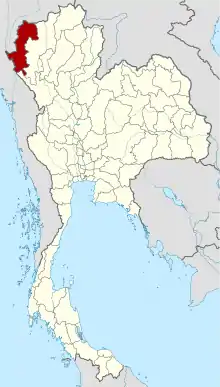 Map of Thailand highlighting Mae Hong Son Province | |
| Country | Thailand |
| Capital | Mae Hong Son |
| Government | |
| • Governor | Suwaphong Kitiphatphibun (since October 2019)[1] |
| Area | |
| • Total | 12,681 km2 (4,896 sq mi) |
| Area rank | Ranked 8th |
| Population (2019)[3] | |
| • Total | 284,138 |
| • Rank | Ranked 70th |
| • Density | 22.3/km2 (58/sq mi) |
| • Density rank | Ranked 77th |
| Human Achievement Index | |
| • HAI (2017) | 0.4637 "low" Ranked 77th |
| Time zone | UTC+7 (ICT) |
| postal code | 58xxx |
| calling code | 052 & 053 |
| ISO 3166 code | TH-58 |
Geography
Location
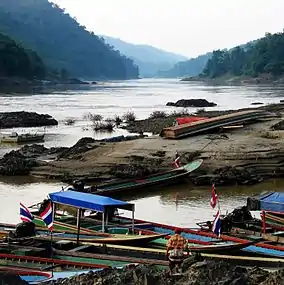
Mae Hong Son Province is approximately 924 kilometres (574 mi) north of Bangkok by road. To the north and west it connects to a total of three states in the Union of Burma, namely the southern portion of Shan State, Kayah State, and Kawthoolei State, via the Dawna Range, and the Salween and Moei Rivers. These formations serve as natural boundaries between the countries. To the south, it borders the district of Tha Song Yang and Tak, via the rivers Yuam and Ngao, which serve as a provincial boundary. To the east it borders the districts of Wiang Haeng, Chiang Dao, Mae Taeng, Mae Chaem, Hot and Omkoi in Chiang Mai Province, via the central and east sections of the Thanon Thongchai mountain ranges, which serve as a boundary between the two provinces.
Every district in Mae Hong Son Province shares a common border, measuring approximately 483 kilometres in total length, with Myanmar. The common border consists of approximately 326 km (203 mi) of land boundary and 157 km (98 mi) of river boundary (not counting the Salween, 127 km (79 mi), and Moei, 30 km (19 mi)).[6]
Topography
Most of the areas of Mae Hong Son Province are the complex mountain ranges of the Thai highlands, parts of which are still covered with rain forest. Of the approximately 6,976,650 rai of national forest reserves, it is estimated that 88% is forested.[7]
The Daen Lao Range, in the northernmost portion of the province, marks the northern boundary between Thailand and Burma, while the Dawna Range in the west serves as the boundary between Thailand and Burma. The Thanon Thongchai Range in the east of the province serves as the boundary between the provinces of Mae Hong Son and Chiang Mai. The highest point of the province is Doi Mae Ya (ยอดเขาแม่ยะ), in the Pai District in the province's northeast, at 2,005 metres (6,578 ft) elevation.[8]
Climate
Mae Hong Son Province has a tropical savanna climate (Köppen climate classification category Aw). Winters are dry and warm. Temperatures rise until May. Mansoon season runs from May through October, with heavy rain and somewhat cooler temperatures during the day, although nights remain warm. Temperature statistics: It's maximum temperature is 44.6 °C (112.3 °F) on 28 April 2016 and the lowest temperature is 3.9 °C (39.0 °F). The highest average temperature is 35.6 °C (96.1 °F) on 25 December 1999 and the minimum average temperature is 18.0 °C (64.4 °F). The average relative humidity is 96.99% and the minimum relative humidity is 20%. Annual rainfall is 1,064.9 millimeters and on 23 April 1968 was for 24 hour the rainfall 130.4 mm. The number of rainy days was 130 days for a year.[9]
Weather box Mae Hong Son and Weather box Mae Sariang
National parks
There are four national parks and one proposed national park, with total area of 3,411 km2 (8,834 mi2).[10]
- Huai Nam Dang National Park, 1,252 km2 (3,243 mi2)
- Salawin National Park, 721 km2 (1,867 mi2)
- Tham Pla-Namtok Phu Suea National park, 630 km2 (1,631 mi2)
- Namtok Mae Surin National park, 396 km2 (1,026 mi2)
- Mae Ngao National park (postponed), 412 km2 (1,067 mi2)
Wildlife sanctuaries
There are six sanctuaries, with a total area of 3,684 km2 (9,541 mi2).[11]
- Lum Nam Pai Wildlife Sanctuary, 1,180 km2 (3,056 mi2)
- Salawin Wildlife Sanctuary, 955 km2 (2,474 mi2)
- Mae Lao-Mae Sae Wildlife Sanctuary, 514 km2 (1,331 mi2)
- Doi Wiang La Wildlife Sanctuary, 466 km2 (1,207 mi2)
- Mae Yuam Fang Khwa Wildlife Sanctuary, 292 km2 (756 mi2)
- Sun Pan Dam Wildlife Sanctuary, 277 km2 (717 mi2)
Water resources
There are 31 water reservoirs with total capacity of 12.31 million cubic meters:
- Huai So Tue, capacity 1,880,000 m3
- Huai Fai Kho, capacity 950,000 m3
- Huai Mae Hong Son, cap. 734,000 m3.
- Huai Mae Salap, cap. 700,000 m3.
There are 617 groundwater wells, which are used to mine groundwater for general use.[12]
Mineral resources
Among the minerals that have been discovered in the province are limestone, coal, lignite, lead, zinc, tin, tungsten, antimony, fluoride, and feldspar. The mineral area is approximately 2,440 km2 (19% of provincial area).[13]
History
Mae Hong Son Province was formerly part of Mawkmai State, one of the Shan States which had been founded in 1767 by Hsai Khiao, from a noble family of Chiang Mai.[14]
As a result of the Anglo-Siamese Boundary Commission of 1892–1893, Mae Hong Son District was ceded to Siam,[15] but the adjacent Möngmaü and Mehsakun trans-Salween Districts also claimed by Siam (as territories on the eastern side of the Salween River), were kept as part of British Burma.[16]
Environment
The Thai government, to solve persistent water shortages in the central region, have proposed a 70.7 billion baht plan to divert some 1.8 billion m3 of water annually from the Yuam River to the perennially underfilled Bhumibol Dam. Several of the province's districts would impacted. As part of the plan, the Royal Irrigation Department (RID), would build 69 metre high dam with a storage capacity of 68.7 million m3 constructed on 2,075 rai of forest land, together with a pumping station on a separate 55 rai plot and a 61.5 kilometre-long tunnel passing through 14 villages. The inhabitants of the area—primarily Karen tribes people—largely oppose the project. In December 2019, the RID submitted a second environmental impact assessment (EIA) to the Office of the Natural Resources and Environmental Policy and Planning (ONEP). ONEP rejected the EIA for the second time due to concerns about forest destruction, tunnel rock waste, and compensation issues.[17]
Administrative divisions
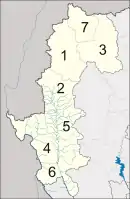
Provincial government
The province is divided into seven districts (amphoes). These are further divided into 45 subdistricts (tambons) and 415 villages (mubans).[18]
Local government
As of 26 November 2019 there are:[19] one Mae Hong Son Provincial Administration Organisation (ongkan borihan suan changwat) and seven municipal (thesaban) areas in the province. Mae Hong Son has town (thesaban mueang) status. There are a further six subdistrict municipalities (thesaban tambon). The non-municipal areas are administered by 42 Subdistrict Administrative Organisations (SAO) (ongkan borihan suan tambon).[3]
Demographics
Ethnic diversity
Shan people is the largest population group in the province. They migrated from Shan State in Myanmar. Further there are seven hill tribes which consists of 63% of the provincial population: Karen, Lahu, Lisu, Lua, Miao, Chinese Yunnan and Pa-O people.
The Karen are not a single group, but rather a mix of closely related tribes. Among the smallest of the Karen tribes in Thailand are Kayan Lahwi. This group's women are recognized by the large brass rings they wear around their necks. Population density is 22 persons per km2, the lowest of all provinces.[20]
Language
- Tai Yai people speak their own language. The written language with round alphabets is like Mon and Burmese script.
- Karen and Chinese Haw have their own spoken and written language.
- Lahu, Lisu and Lua people have their own spoken language, but their written language uses the Latin alphabet.[21]
Religion
Most inhabitants, 77.5%, are Buddhists, followed by Christians at 20.9%, and Muslims at 0.5%. About 1.1% believe in animism and other religions.[22]
Symbols
The provincial seal, Rup chang nai thong nam (รูปช้างในท้องน้ำ), meaning 'image of an elephant in a body of water', is a reference to the training of wild elephants for battle and various types of animal labour. "Rup chang nai thong nam" was selected as the provincial seal because it refers to Mae Hong Son's founding, which began with Lord Kaeo of Ma being sent to capture elephants for the Lord of Chiang Mai (1825–1846). Once in Mae Hong Son, he gathered the scattered Shan settlements to establish two main villages, Ban Pang Mu and Ban Mae Hong Son, that would be ruled by their elected leaders.
The provincial flag is horizontally divided in dark brown/blue/dark brown (1:3:1) with the image of the provincial seal in the middle of the flag.[23]
The provincial tree is the Millettia brandisiana (Thai: กระพี้จั่น; RTGS: kraphichan).
The provincial flower is the Tree marigold (Thai: บัวตอง; RTGS: buatong).
The provincial animal is the Blyth's river frog (Thai: กบภูเขา; RTGS: kobphukhao).
The official provincial slogan promoted by the Thai government is หมอกสามฤดู กองมูเสียดฟ้า ป่าเขียวขจี ผู้คนดี ประเพณีงาม ลือนามถิ่นบัวตอง (RTGS: mok sam ruedu, kong mu siat fa, pa khiao khachi, phu khon di, prapheni ngam, lue nam thin bua tong) 'Mists throughout the three seasons, the Kong Mu (monastery) that scrapes the sky, verdant forests, gentle people, beautiful customs; renowned land of marigolds'.
Infrastructure
Education
Higher educational institutions are:
- Chiang Mai Rajabhat University, Mae Hong Son campus.[24]
- Mae Hong Son Community College.[25]
- Nawamintrachinaracha Industrial and Community Education College.
- Mae Sariang Industrial and Community Education College.
There are eight secondary schools in Mae Hong Son.[26]
Healthcare
Every district has a hospital. There are also 72 subdistrict health-promoting hospitals. There are 63 public health centers, 10 insect-induced disease control centers, 15 malaria clinics, 21 community malaria centers and one health service (Thanyarak Mae Hong Son hospital).[27]
Roads
There are four major roads in the province:[28]
- Hot District of Chiang Mai to Mae Hong Son, distance 345 km
- Mae Tang District of Chiang Mai Province to Mae Hong Son, distance 246 km.
- Mae Sot District of Tak Province to Mae Hong Son.
- Mae Chaem District of Chiang Mai Province to Khun Yuam District of Mae Hong Son Province, distance 90 km.
Public transport
Two bus companies (Prem Pracha Transport Co and Sombat Tour Co.) operate four bus services:[29]
- Bangkok - Mae Hong Son, distance is 928 km, travel time is 17 hours.
- Chiang Mai - Mae Sariang - Mae Hong Son, distance is 359 km, travel time is eight hours.
- Chiang Mai (Pai District) - Mae Hong Son, distance is 250 km, travel time is six hours.
- Mae Sot District of Tak Province - Mae Sariang District of Mae Hong Son.
Air transport
Bangkok Airways provides daily flights between Chiang Mai International Airport and Mae Hong Son Airport.[30] From 2011 until April 2017 Kan Air provided flights between Chiang Mai International Airport and Pai Airport.
Electricity
Mae Hong Son is supplied with electricity from power stations in Chiang Mai Province (Districts Chom Thong, Hot and Mae Taeng), along with eight power plants in Mae Hong Son Province:[31]
- Pha Bong Dam Hydro Plant
- Mae Sa Nga Dam Hydro Plant
- Mae Sariang Hydro Plant
- Mae Hong Son Diesel Power Plant
- Pha Bong Solar Power Plant
In 2015, 83% of households were electrified and the remainder were without electricity.[32]
Communications
As of 2018 there were 65,153 households, of which 2.1% used telephones, 15.2% used computers with no internet connection, and 45.5% used computers with internet. As of 2018 there were 182,615 people aged six years and older, of which 22.2% used computers, 38.9% the internet, and 81.3% used mobile phones.[33]
Human achievement index 2017
| Health | Education | Employment | Income |
| 45 | 75 | 9 | 74 |
| Housing | Family | Transport | Participation |
 |
 |
 |
|
| 76 | 69 | 77 | 19 |
| Province Mae Hong Son, with an HAI 2017 value of 0.4637 is "low", occupies place 77 in the ranking. | |||
Since 2003, United Nations Development Programme (UNDP) in Thailand has tracked progress on human development at sub-national level using the Human achievement index (HAI), a composite index covering all the eight key areas of human development. National Economic and Social Development Board (NESDB) has taken over this task since 2017.[4]
| Rank | Classification |
| 1 - 15 | "high" |
| 16 - 30 | "somewhat high" |
| 31 - 45 | "average" |
| 45 - 60 | "somewhat low" |
| 61 - 77 | "low" |
| Map with provinces and HAI 2017 rankings |
 |
Events and festivals
- Poi Sang Long Procession (งานประเพณีปอยส่างลอง)
- Chong Phara Procession (งานประเพณีจองพารา)
- Bua Tong Blossom Festival (งานวันดอกบัวตองบาน)
- Loi Krathong Festival (ประเพณีลอยกระทง หรือ งานเหลินสิบสอง)
- Small World Festival http://www.sawadee.com/thailand/festivals/festival12.html[34]
Gallery
 Bua tong (tree marigold) field in Doi Mae-U-Kho, Khun Yuam
Bua tong (tree marigold) field in Doi Mae-U-Kho, Khun Yuam Entrance of Doi Kham-Wiang Haeng viewpoint, the border of Mae Hong Son and Chiang Mai
Entrance of Doi Kham-Wiang Haeng viewpoint, the border of Mae Hong Son and Chiang Mai Tham than lot, also known as Tham phi man (spirit cave)
Tham than lot, also known as Tham phi man (spirit cave)_-_Corner_of_forest.jpg.webp) Pang Oung, a romantic reservoir in Mueang Mae Hong Son
Pang Oung, a romantic reservoir in Mueang Mae Hong Son Historic Pai Memorial Bridge in Pai
Historic Pai Memorial Bridge in Pai.jpg.webp)
 Morning atmosphere in Pang Mapha
Morning atmosphere in Pang Mapha.jpg.webp)
 Long Neck Karen, a tribal group who living on the hills on the Mae Hong Son-Myanmar border.
Long Neck Karen, a tribal group who living on the hills on the Mae Hong Son-Myanmar border. Reflections on the water surface of the lake in front of Wat Chong Klang, a temple in Mueang Mae Hong Son
Reflections on the water surface of the lake in front of Wat Chong Klang, a temple in Mueang Mae Hong Son
See also
Notes
Reports (data) from Thai government are "not copyrightable" (Public Domain), Copyright Act 2537 (1994), section 7.
References
- "ประกาศสำนักนายกรัฐมนตรี เรื่อง แต่งตั้งข้าราชการพลเรือนสามัญ" [Announcement of the Prime Minister's Office regarding the appointment of civil servants] (PDF). Royal Thai Government Gazette. 136 (Special 242 Ngor). 18. 28 September 2019. Retrieved 24 November 2019.
- Advancing Human Development through the ASEAN Community, Thailand Human Development Report 2014, table 0:Basic Data (PDF) (Report). United Nations Development Programme (UNDP) Thailand. pp. 134–135. ISBN 978-974-680-368-7. Retrieved 17 January 2016, Data has been supplied by Land Development Department, Ministry of Agriculture and Cooperatives, at Wayback Machine.
- "รายงานสถิติจำนวนประชากรและบ้านประจำปี พ.ศ.2562" [Statistics, population and house statistics for the year 2019]. Registration Office Department of the Interior, Ministry of the Interior (in Thai). 31 December 2019. Retrieved 10 March 2020, archiving is not necessary because DOPA provides data from 1993 to future years.
- Human achievement index 2017 by National Economic and Social Development Board (NESDB), pages 1-40, maps 1-9, retrieved 14 September 2019, ISBN 978-974-9769-33-1
- "Richest 0.1% own half of nation's assets". The Nation. 23 September 2014. Retrieved 30 October 2016.
- "Location". Mae Hong Son. 2018. Retrieved 2 September 2019.
- "Forest resources". Mae Hong Son. 2018. Retrieved 2 September 2019.
- "Topography". Mae Hong Son. 2018. Retrieved 2 September 2019.
- "Climate". Mae Hong Son. 2018. Retrieved 2 September 2019.
- "National Parks". Mae Hong Son. 2018. Retrieved 2 September 2019.
- "Wildlife sanctuaries". Mae Hong Son. 2018. Retrieved 2 September 2019.
- "Water resources". Mae Hong Son. 2018. Retrieved 2 September 2019.
- "Mineral resources". Mae Hong Son. 2018. Retrieved 2 September 2019.
- Ben Cahoon (2000). "World Statesmen.org: Shan and Karenni States of Burma". worldstatesmen.org. Retrieved 21 December 2010.
- Home News General - Thailand and Britain Swap Boundary Maps Archived 2015-12-25 at the Wayback Machine
- Imperial Gazetteer of India, v. 17, p. 236.
- Boonlert, Thana (7 April 2020). "Yuam River dam diverts more than just flow". Bangkok Post. Retrieved 7 April 2020.
- "Changwat Amphoe Tambon Khet Kwang version 14" (PDF). Office of the Royal Society. 2019. Retrieved 2 September 2019 page 152
- "Number of local government organizations by province". Department of Local Administration (DLA). 26 November 2019. Retrieved 10 December 2019.
43 Mae Hong Son: 1 PAO, 1 Town mun., 6 Subdistrict mun., 42 SAO.
- "Population". Mae Hong Son. 2018. Retrieved 2 September 2019.
- "Language". Mae Hong Son. 2018. Retrieved 2 September 2019.
- "Religion". Mae Hong Son. 2018. Retrieved 2 September 2019.
- "Symbols". Mae Hong Son. 2018. Retrieved 2 September 2019.
- "Chiang Mai Rajabhat University, Mae Hong Son campus". www.wikipedia.org.
- "Mae Hong Son Community College". www.wikipedia.org.
- "Education". Mae Hong Son province. maehongson.go.th. 2018. Retrieved 2 September 2019.
- "Healthcare". Mae Hong Son. 2018. Retrieved 2 September 2019.
- "Roads". Mae Hong Son. 2018. Retrieved 2 September 2019.
- "Public transport". Mae Hong Son. 2018. Retrieved 2 September 2019.
- "Air transport". Mae Hong Son. 2018. Retrieved 2 September 2019.
- "Power stations". Mae Hong Son. 2018. Retrieved 9 September 2019.
- "Electricity". Mae Hong Son. 2018. Retrieved 2 September 2019.
- http://statbbi.nso.go.th/staticreport/page/sector/en/16.aspx
- "Small World Mae Hong Son Festival". Sawasddd.com. Web Sawadee Public Company Limited. Retrieved 6 December 2017.
Further reading
- "A Season in Mae Hong Son", in: Forbes, Andrew, and Henley, David, Ancient Chiang Mai Volume 3. Chiang Mai, Cognoscenti Books, 2012. ASIN: B006IN1RNW
External links
 Mae Hong Son travel guide from Wikivoyage
Mae Hong Son travel guide from Wikivoyage
| Wikimedia Commons has media related to Mae Hong Son Province. |